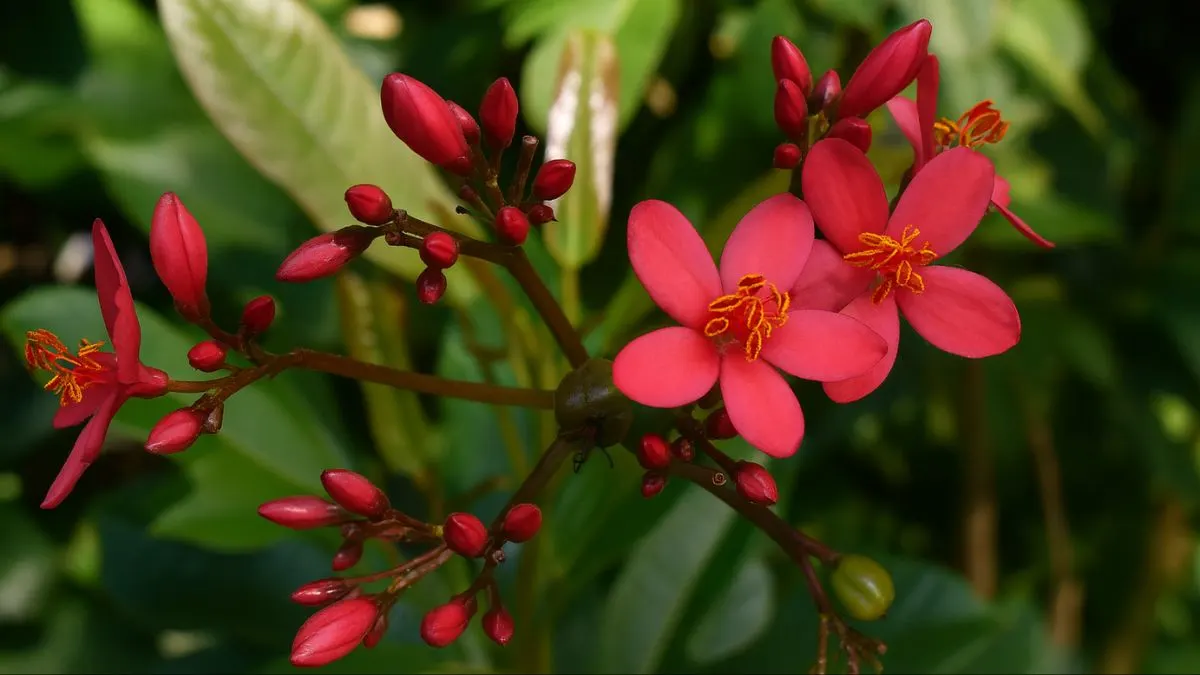In the world of tropical plants, few species combine beauty, resilience, and utility as elegantly as the Jatropha plant. With its vibrant red flowers and oil-rich seeds, this versatile shrub is both ornamental and practical. Beyond being admired for its striking looks, Jatropha is a tropical plant known for its oil-rich seeds, used in sustainable biofuel production. For gardeners, farmers, and environmentalists, Jatropha offers lessons in both survival and sustainability.
Let’s dive into everything you need to know about the Jatropha plant—from its history and varieties to care tips, benefits, and global importance.
Origins and Botanical Background

The Jatropha plant is a small tree from the Euphorbiaceae family. Botanically, it’s part of a group of shrubs and trees adapted to thrive in hot, dry climates.
- It is a tropical shrub native to Mexico and Central America, spreading across Asia and Africa due to its commercial value.
- Farmers quickly adopted it for its resilience—it can withstand poor soils and long dry seasons.
- Scientifically, Jatrophas are oil plants belonging to the Euphorbiaceae family, a group known for their medicinal and economic uses.
Key Varieties of Jatropha
1. Jatropha curcas
-
- The most famous variety, cultivated for its oil-rich seeds.
- Seeds are pressed for biofuel and soap production.
- Hardy and drought-resistant.
2. Jatropha integerrima (Jatropha red)
-
- Ornamental type, often called Jatropha red, admired for its clusters of bright flowers.
- Jatropha red is a striking and versatile plant, perfect for landscaping in tropical and subtropical gardens.
3. Jatropha gossypifolia
-
- Known as bellyache bush.
- Used in traditional medicine but invasive in some regions.
Also Read: Grow Clarkia and Watch Your Garden Explode With Color!
Growing Conditions and Care
One reason gardeners love Jatropha is how easy it is to care for.
- They can easily survive drought and grow in partial or full sunlight.
- Jatrophas prefer sandy, well-draining soils but adapt to a range of conditions.
- While drought-tolerant, occasional watering in extremely dry months helps them bloom more vibrantly.
- Fertilizing with compost enhances growth and flowering.
If you live in a warm climate (like Florida, Southern California, or tropical Canada greenhouses), Jatropha can thrive with minimal effort.
Planting Tips
When planting Jatropha in your garden:
- Choose a spot with partial or full sunlight.
- Dig a wide pit, enrich it with compost, and set the plant firmly.
- Water regularly during the first few months to establish strong roots.
- Once mature, the plant requires very little maintenance.
Personal Experience: When I introduced Jatropha red into my balcony garden, it transformed the space. The deep green foliage combined with the vivid blooms became an instant conversation starter.
Benefits of Jatropha
The Jatropha plant is not just about beauty—it’s about functionality.
1. Biofuel Production
The most important use lies in its seeds. Jatropha is a tropical plant known for its oil-rich seeds, which are processed into biodiesel. This makes it a renewable alternative to fossil fuels.
2. Ornamental Value
With its bright flowers, Jatropha red is a striking and versatile plant for hedges, borders, and gardens. It adds color throughout the year in tropical regions.
3. Environmental Role
- Prevents soil erosion.
- Can be grown in barren or marginal lands where other crops fail.
- Supports reforestation projects in dry climates.
4. Medicinal Uses
Traditional medicine in Central America and Asia uses Jatropha extracts for skin conditions, digestive issues, and wound healing.
Also Read: Bring Home These 10 Water Plants for Beauty, Peace & Clean Air
Challenges and Considerations
While Jatropha has many benefits, it comes with a few warnings:
- The seeds are toxic if ingested raw, so they must be processed before use.
- Invasive species like Jatropha gossypifolia spread aggressively if not controlled.
- Commercial biofuel ventures have faced challenges due to unpredictable yields.
Jatropha in Landscaping
For homeowners in the USA, Canada, and across the world, Jatropha is increasingly popular in ornamental gardening.
- Jatropha red shines in warm gardens, balconies, or poolside spaces.
- The plant provides color even when many others fade in the heat.
- It works as both a specimen plant and a hedge.
If you’re designing a sustainable garden, Jatropha is an excellent choice.
Quick Comparison Table
Variety |
Feature |
Use |
Sunlight Needs |
Jatropha curcas |
Oil-rich seeds |
Biofuel, Soap, Fertilizer |
Full/Partial Sun |
Jatropha red |
Striking red flowers |
Ornamental, Landscaping |
Full Sun |
Jatropha gossypifolia |
Medicinal but invasive |
Folk medicine, Dye |
Full Sun |
The Jatropha plant is proof that nature often combines beauty with purpose. From a small tree from the Euphorbiaceae family with roots in Mexico and Central America, it has spread worldwide as both an ornamental and an oil crop.
If you’re looking for a plant that delivers both prosperity and resilience, the Jatropha plant is a tropical gem you’ll definitely want to add to your collection.






